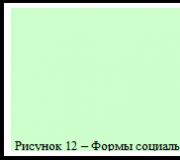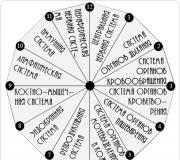A combination of folklore fantasy and real horse. Project on literary criticism "Folklore motifs in fairy tales M
A special place in the work of Saltykov-Shchedrin is occupied by fairy tales with their allegorical images, in which the author was able to say more about Russian society of the 60-80s of the 19th century than the historians of those years. Saltykov-Shchedrin writes these tales “for children of considerable age”, that is, for an adult reader, mentally in the state of a child who needs to open his eyes to life. The fairy tale, due to the simplicity of its form, is accessible to anyone, even an inexperienced reader, and therefore is especially dangerous for those who are ridiculed in it.
The main problem of Shchedrin's fairy tales is the relationship between the exploiters and the exploited. The writer created a satire on Tsarist Russia. The reader is presented with images of rulers (“Bear in the Voivodeship”, “Eagle Patron”), exploiters and exploited (“ Wild landowner", "The story of how one man fed two generals"), ordinary people (" The wise minnow", "Dried roach").
The fairy tale “The Wild Landowner” is directed against everything social order, based on exploitation, anti-people in its essence. Keeping the spirit and style folk tale, the satirist talks about real events his contemporary life. The work begins as an ordinary fairy tale: “In a certain kingdom, in a certain state, there lived a landowner...
"But then an element appears modern life: “And that stupid landowner was reading the newspaper “Vest”.” “Vest” is a reactionary-serf newspaper, so the stupidity of the landowner is determined by his worldview. The landowner considers himself a true representative of the Russian state, its support, and is proud that he is a hereditary Russian nobleman, Prince Urus-Kuchum-Kildibaev.
The whole point of his existence comes down to pampering his body, “soft, white and crumbly.” He lives at the expense of his men, but he hates and is afraid of them, and cannot stand the “servile spirit.” He rejoices when, by some fantastic whirlwind, all the men were carried away to who knows where, and the air in his domain became pure, pure.
But the men disappeared, and such hunger set in that it was impossible to buy anything at the market. And the landowner himself went completely wild: “He’s all overgrown with hair, from head to toe...
and his nails became like iron. He stopped blowing his nose a long time ago and walked more and more on all fours.
I’ve even lost the ability to pronounce articulate sounds...” In order not to die of hunger, when the last gingerbread was eaten, the Russian nobleman began to hunt: if he spots a hare, “like an arrow will jump from a tree, grab onto its prey, tear it apart with its nails, and eat it with all the insides, even the skin.” The savagery of the landowner indicates that he cannot live without the help of the peasant.
After all, it was not without reason that as soon as the “swarm of men” was caught and put in place, “flour, meat, and all kinds of living creatures appeared at the market.” The stupidity of the landowner is constantly emphasized by the writer. The peasants themselves were the first to call the landowner stupid; representatives of other classes call the landowner stupid three times (triple repetition technique): actor Sadovsky (“However, brother, you are a stupid landowner!
Who gives you a wash, stupid one?”), the generals, whom he treated instead of “beef” to printed gingerbread cookies and candies (“However, brother, you’re a stupid landowner!”) and, finally, the police captain (“You’re a stupid you, Mr. Landowner!
"). The landowner's stupidity is visible to everyone, but he indulges pipe dreams that without the help of the peasants he will achieve prosperity in the economy, reflects on English machines that will replace the serfs. His dreams are absurd, because he cannot do anything on his own.
And only one day the landowner thought: “Is he really a fool? Could it be that the inflexibility that he so cherished in his soul, when translated into ordinary language, means only stupidity and madness?
“If we compare the well-known folk tales about the master and the peasant with the tales of Saltykov-Shchedrin, for example, with “The Wild Landowner,” we will see that the image of the landowner in Shchedrin’s fairy tales is very close to folklore, and the peasants, on the contrary, differ from those in fairy tales. In folk tales, a quick-witted, dexterous, resourceful man defeats a stupid master.
And in “The Wild Landowner” there arises collective image workers, breadwinners of the country and at the same time patient martyrs and sufferers. Thus, modifying a folk tale, the writer condemns the people's long-suffering, and his tales sound like a call to rise up to fight, to renounce the slave worldview.
Of all the arts, literature has the richest possibilities for embodying the comic. Most often, the following types and techniques of comedy are distinguished: satire, humor, grotesque, irony.
Satire is called looking “through a magnifying glass” (V.). The object of satire in literature can be a variety of phenomena.
Political satire is most common. A clear proof of this is the fairy tales of M.
E. Saltykova-Shchedrin.
Fantastic fairy tales allowed Saltykov-Shchedrin to continue criticizing the social system, bypassing censorship even in the face of political reaction. Shchedrin's fairy tales depict not just evil or good people, not just a struggle between good and evil, like most folk tales, they reveal the class struggle in Russia in the second half of the 19th century century.
Let us consider the features of the problems of the writer’s fairy tales using the example of two of them. In “The Tale of How One Man Fed Two Generals,” Shchedrin shows the image of a hard worker-breadwinner.
He can get food, sew clothes, conquer the elemental forces of nature. On the other hand, the reader sees the man’s resignation, his humility, his unquestioning submission to the two generals. He even ties himself to a rope, which once again indicates the submissiveness and downtroddenness of the Russian peasant.
The author calls on the people to fight, protest, calls to wake up, think about their situation, and stop submitting meekly. In the fairy tale “The Wild Landowner,” the author shows to what extent a rich gentleman can sink when he finds himself without a man. Abandoned by his peasants, he immediately turns into a dirty and wild animal, moreover, he becomes a forest predator.
And this life, in essence, is a continuation of his previous predatory existence. Worthy appearance the wild landowner, like the generals, acquires again only after his peasants return. Thus, the author gives an unambiguous assessment of contemporary reality.
In its own way literary form and style of Saltykov-Shchedrin's tales are associated with folklore traditions. In them we meet traditional fairy tale characters: talking animals, fish, birds. The writer uses the beginnings, sayings, proverbs, linguistic and compositional triple repetitions, vernacular and everyday peasant vocabulary characteristic of a folk tale, constant epithets, words with diminutive suffixes.
As in folk tale, Saltykov-Shchedrin does not have a clear time and spatial framework. But using traditional techniques, the author quite deliberately deviates from tradition.
He introduces socio-political vocabulary, clerical phrases, French words. The pages of his fairy tales include episodes of modern society.
life. This is how styles mix, creating comic effect, and connecting the plot with the problems of our time.
Thus, enriching the tale with new satirical techniques, Saltykov-Shchedrin turned it into a tool of socio-political satire.
1. Satire by Saltykov-Shchedrin.
2. Genre features fairy tales
3. Heroes.
4. Fantastic motives.
The fairy tales of M. E. Saltykov-Shchedrin are a completely special layer of the writer’s creativity. Almost everything Saltykov-Shchedrin created in last years life. These short works amaze with variety artistic techniques, as well as yours social significance. The writer addresses his “fairy tales” to “children of a fair age.” Thus, Saltykov-Shchedrin seems to want to debunk the naive illusions of some adults who are accustomed to looking at the world through rose-colored glasses. The writer treats his readers harshly and does not spare them. Saltykov-Shchedrin's satire in fairy tales is especially sharp and merciless. The writer uses fantastic motifs to emphasize social contradictions. He can be poisonous and merciless. But otherwise his works would not be so accurate and truthful. I. S. Turgenev wrote about the work of Saltykov-Shchedrin: “I saw listeners writhing with laughter when reading some of Saltykov’s essays. There was something scary in that laughter. The audience, laughing, at the same time felt like a scourge was lashing itself.” The writer used satire to make readers think about social contradictions, to arouse indignation in their minds about what is happening around them.
It was not by chance that Saltykov-Shchedrin chose the fairy tale genre. Thanks to allegory, he could openly express his opinion on the most various issues. Saltykov-Shchedrin managed to harmoniously connect the genres of fairy tales and fables. From fairy tales the writer borrowed such genre techniques as unexpected transformations and the location of the action (the writer often says: “in a certain kingdom...”). The fable genre is manifested in the choice of heroes. The wolf, hare, bear, eagle, crow and other animals, birds and fish are perceived by the reader as masks behind which quite recognizable faces from the human world are hidden. Under the masks of representatives of the animal world, Saltykov-Shchedrin shows character traits different social types. The topical content of fairy tales is only emphasized by the intensity of passions that are characteristic of each fairy tale. Saltykov-Shchedrin aimed to use a grotesquely ugly form to show vices public life, and weak sides of people. It is easy to recognize human characters behind the heroes of fairy tales, the writer shows them so recognizable. If Saltykov-Shchedrin makes people heroes of fairy tales, then he depicts a fantastic situation. People who find themselves in the center of this situation look very unattractive. Fantasy in fairy tales is an extraordinary situation. And everything else - human types, characters - this is all quite real. All fairy tales, without exception, are very interesting. For example, the fairy tale “The Wild Landowner” shows us a very stupid and short-sighted master. He always enjoyed the fruits of the labors of his peasants, but did not appreciate it at all. Moreover, the master turned out to be so stupid that he decided to get rid of the peasants. His wish came true. What happened after that? The landowner degenerated and became wild. The fantastic thing in the fairy tale is the situation when the stupid master’s wish came true, and the peasants disappeared from his estate. The fantastic nature of the tale shows that the well-being of the landowner rested solely on the peasants. And as soon as the peasants were gone, the landowner turned into wild beast. The harsh truth of this tale is that the ruling class takes advantage of the labors ordinary people and at the same time does not appreciate them at all.
Saltykov-Shchedrin repeatedly emphasizes the wretchedness, stupidity, and short-sightedness of representatives of the ruling class. For example, the fairy tale “The Tale of How One Man Fed Two Generals” makes you think about how helpless the generals are and how strong and savvy the common man is. The generals cannot do without his help, and he himself lives well alone. Saltykov-Shchedrin gives animals human traits and reproduces any social situation. In the fairy tale " Selfless hare“The hare is cowardly, weak, indecisive. He is a typical victim, humiliated and helpless. The wolf is vested with power, personifies the master. The hare puts up with his position as a slave and does not try to do anything to change his life. The despot wolf revels in power, humiliating the unfortunate victim. People are visible under the masks of animals. Tales of Saltykov-Shchedrin - realistic works. The writer calls a spade a spade using allegory. In the fairy tale “The Selfless Hare,” the wolf says: “Because you didn’t stop at my first word, here’s my decision for you: I sentence you to be deprived of your belly by being torn to pieces. And since now I’m full, and my wolf is full, and we have enough reserves for another five days, then sit under this bush and wait in line. Or maybe... ha ha... I’ll have mercy on you.” He is clearly mocking the victim. But the trouble is that the victim deserves such treatment. After all, a slavishly obedient hare is devoid of pride and self-respect. He represents the common people, patient, humble and helpless. From the point of view of Saltykov-Shchedrin, all these qualities deserve reproach. The writer considered satire effective and effective weapon, capable of opening eyes to various social and personal vices.
The writer's fairy tales occupy a very important place in the treasury of Russian literature. Their relevance is obvious even now, when a lot of time has passed since they were written. There are also phenomena in society that deserve sharp condemnation.
M. E. Saltykov-Shchedrin created more than 30 fairy tales. Turning to this genre was natural for the writer. Fairy-tale elements (fantasy, hyperbole, convention, etc.) permeate all of his work. Themes of fairy tales: despotic power (“The Bear in the Voivodeship”), masters and slaves (“The Tale of How One Man Fed Two Generals,” “The Wild Landowner”), fear as the basis slave psychology(“The Wise Minnow”), hard labor (“The Horse”), etc. The unifying thematic principle of all fairy tales is the life of the people in its correlation with the life of the ruling classes.
What brings Saltykov-Shchedrin’s fairy tales closer to folk tales? Typical fairy tale beginnings (“Once upon a time there were two generals...”, “In a certain kingdom, in a certain state, there lived a landowner...”; sayings (“according to pike command", "neither to say in a fairy tale, nor to describe with a pen"); phrases characteristic of folk speech (“thought and thought”, “said and done”); close to vernacular syntax, vocabulary, orthoepy. As in folk tales, a miraculous incident sets the plot in motion: two generals “suddenly found themselves on a desert island”; by the grace of God, “there is no longer a peasant throughout the entire domain of the stupid landowner.” Folk tradition Saltykov-Shchedrin also follows in fairy tales about animals, when in an allegorical form he ridicules the shortcomings of society.
Differences. Interweaving the fantastic with the real and even historically accurate. “A Bear in the Voivodeship” - among the animal characters, the image of Magnitsky, a well-known reactionary in Russian history, suddenly appears: even before the Toptygins appeared in the forest, Magnitsky destroyed all the printing houses, students were sent to be soldiers, academicians were imprisoned. In the fairy tale “The Wild Landowner,” the hero gradually degrades, turning into an animal. Incredible story The hero’s character is largely explained by the fact that he read the newspaper “Vest” and followed its advice. Saltykov-Shchedrin simultaneously respects the form of a folk tale and destroys it. The magical in Saltykov-Shchedrin’s fairy tales is explained by the real; the reader cannot escape reality, which is constantly felt behind the images of animals and fantastic events. Fairy-tale forms allowed Saltykov-Shchedrin to present ideas close to him in a new way, to show or ridicule social shortcomings.
“The Wise Minnow” is an image of a frightened man in the street who “is only saving his cold life.” Can the slogan “survive and not get caught by the pike” be the meaning of life for a person?




